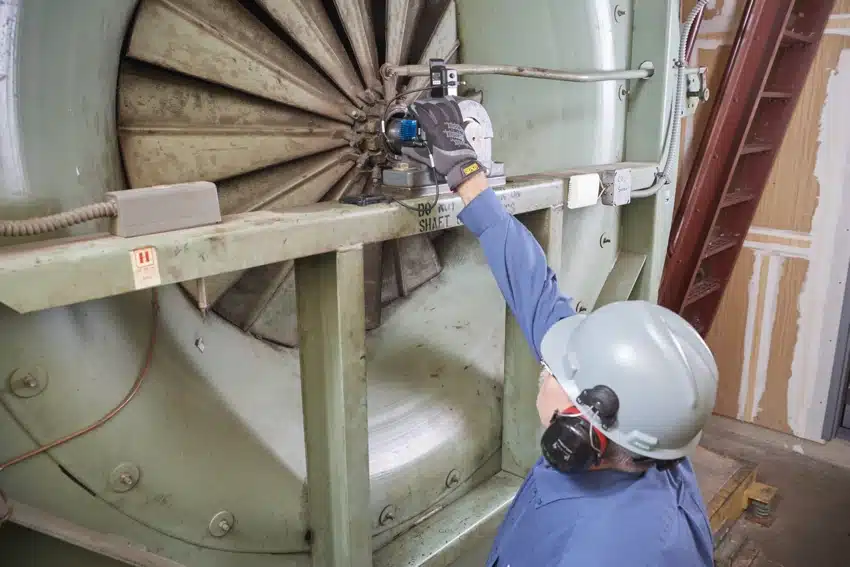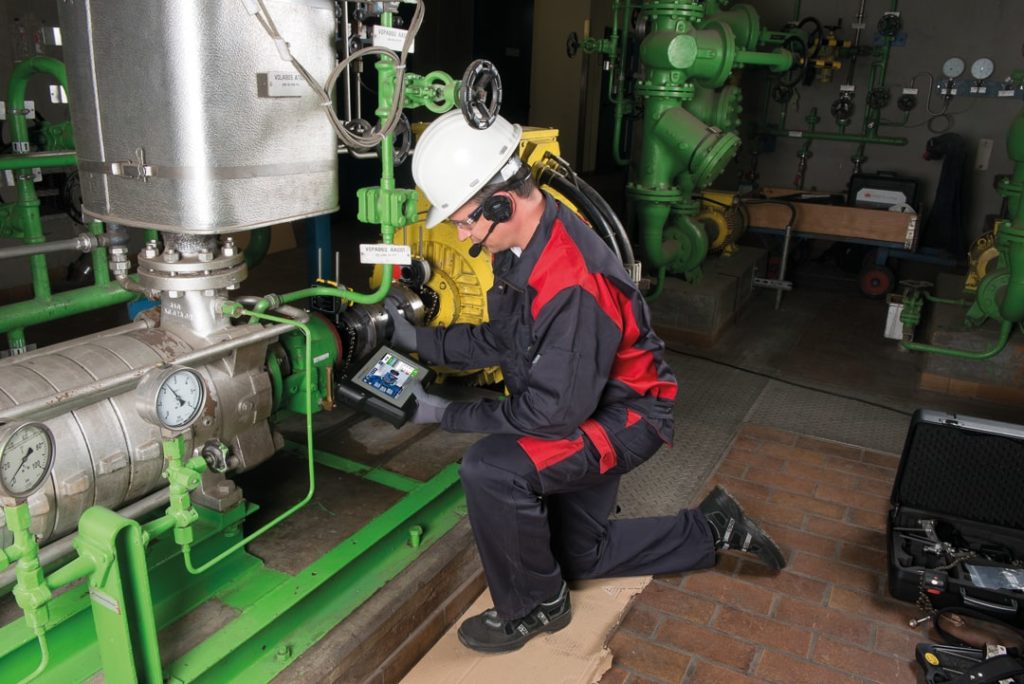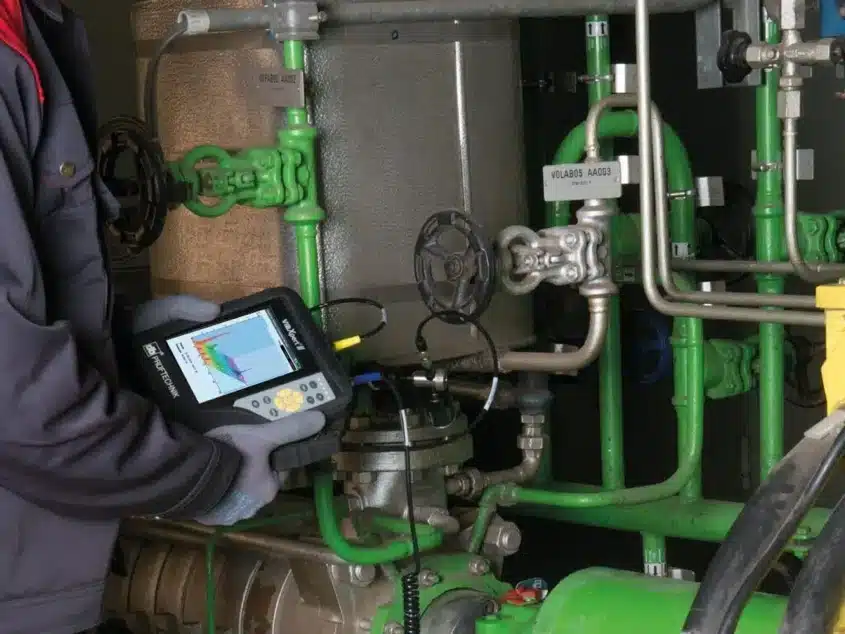Rotational unbalance is one of the leading causes of damage in rotating machines. This common problem has many causes, but it can easily be corrected by using the right tools to discover and repair the root cause of the rotational unbalance.
In this article, we’ll take a look at the different types of rotational unbalance and some of its root causes. We’ll also talk about how to solve this problem and how condition monitoring can lead to early detection and correction of rotational unbalance.

What is Unbalance in Rotating Machinery?
Rotational unbalance is a misalignment of the rotational axis with the gravitational axis. Simply put, rotational unbalance happens when weight is distributed unevenly around an asset’s axis of rotation. As the axis rotates, the unbalance causes vibration, uneven wear on components, noise, and other problems. Rotational unbalance, rotational imbalance, and rotating unbalance are all names for the same problem.
In order to rotate correctly, the rotor’s center of gravity needs to align with its center of rotation. An unbalanced rotor can’t rotate smoothly. It wobbles, creating excess friction, vibration, and noise in the process. Over time, this wears away at bearings and can cause major damage to your components.
Major rotational imbalance is obvious and dramatic. But even a seemingly minor unbalance can cause serious damage and make your asset less efficient. Over time, unbalance leads to increased wear and tear, more maintenance work orders, and more frequent breakdowns. This problem gets even worse without vibration monitoring or other fault screening methods. Understanding what rotational unbalance is and how to address it is an important part of preventive maintenance for rotating equipment.
It’s worth noting that there are three different kinds of unbalance:
- Static unbalance
- Couple unbalance
- Dynamic unbalance
The first, static unbalance, occurs when the gravitational center of rotation is offset from the rotating centerline. In this type of unbalance, the principal inertia axis is parallel to the rotational centerline. If the machine is at rest and able to spin freely, the heavier side will naturally fall to the bottom of the machinery. This is a key indicator of static unbalance.
The second type of unbalance is couple unbalance. In this type of unbalance, there are two equally sized unbalances offset from each other by 180 degrees. The rotational axis and the principal inertia axis intersect with each other but are not aligned. Symptoms of this type of unbalance can include wobbling or twisting motions while the machine is in use.
The third type of rotational unbalance is dynamic unbalance. Dynamic unbalance is the most common type of unbalance.

What is Dynamic Imbalance?
Dynamic imbalance, also known as dynamic unbalance, is so common because it’s a combination of both static and couple imbalance.
Static unbalance means that the rotating mass is unbalanced at its center of gravity.
Couple unbalance means that the principal inertia axis (the axis passing through the object’s center of gravity) is out of balance with the rotational axis.
Dynamic unbalance means that the principal inertia axis does not intersect with the rotational axis. Dynamic unbalance is caused when a component is unbalanced along two different planes instead of having excess weight in just one plane. The result is excess vibration and oscillation along the different planes.
The most common way to correct unbalance is by strategically placing weights on rotating components to offset the gravitational forces that cause the unbalance. However, correcting dynamic unbalance can be more challenging than correcting the other types of unbalance due to the increased number of factors that need to be addressed. A good field balancing tool like the VIBXPERT II can help diagnose dynamic unbalance and give you the information you need to correct it.
Why Is Reducing Rotational Unbalance Important?
Rotating equipment is designed to transfer energy between components or convert one form of energy into another, such as mechanical to electrical or fluid energy. When the rotational forces are unbalanced, the efficiency of this transfer decreases. Instead of being effectively transmitted to the intended output, some of the energy is lost as vibrations, heat, or noise reduce overall system performance.
Rotational unbalance causes high vibration levels, overheating, and premature wear and tear on machine bearings. Over time, unbalance can shorten the lifecycle of your assets. Left unaddressed, it will also lead to more frequent breakdowns and to increased maintenance costs.
This problem can have a domino effect. Unbalance, when left unchecked, leads to reduced productivity and costly unplanned downtime. It can eventually cause complete asset failure, requiring total replacement and creating an environment that is unsafe for employees to work in.
Fortunately, rotational unbalance is not hard to resolve. The right balancing tools can correct balance issues in your rotating machinery before the problem becomes serious. In fact, applying those tools is a key aspect of any predictive or condition-based maintenance strategy. Even if you don’t have these types of maintenance programs in place, scheduling a regular rotational unbalance check is an easy way to make a big difference throughout your plant.
What Causes Rotational Imbalance?
A range of issues can contribute to unbalance. Here are some of the most common causes:
Heat distortion, also called thermal growth, can cause metal components to expand. In the process, their shape gets warped. This changes the component’s center of gravity and causes the rotor to become unbalanced. Components heat up when they are being used, and even ambient temperature increases from other machinery in the plant can cause heat distortion. Accounting for thermal growth is key to avoiding unbalance.
Corrosion over time can cause rotational imbalance by altering the distribution of weight around the center of rotation. Bearings, pumps, wheels, seals, and other components can corrode with use. Over time, stress caused by normal operation can force the rotor to adjust, throwing off the center of rotation.
Buildup from foreign particles can cause imbalance in rotating machines. Over time, machines operating in industrial conditions will often gather dust, or become permeated with oil. An uneven buildup of these materials shifts the balance of weight around the rotor and leads to unbalance.
Missing balance weights can create rotational unbalance. Balance weights are intended to keep the asset operating smoothly. When they fall off or are accidentally removed, the whole asset can become unbalanced. They can also cause unbalance if they are placed incorrectly or moved to the incorrect location on the asset.
Bent or broken shafts can change the weight distribution of an asset. Even a slightly bent shaft can lead to rotational imbalance that worsens as the machine continues to operate. Ensuring proper shaft alignment is essential.
Incorrect assembly during the initial machine set up can cause rotational unbalance.
Replacement parts that are improperly machined can also lead to unbalance issues due to incorrect shape or uneven material density.
While there are many reasons for unbalance in rotating machinery, they all lead to the same end result: unbalanced equipment that, left untreated, can lead to a ripple effect of problems.
What Is the Primary Consequence of Imbalanced Rotating Machinery?
Rotational unbalance does not resolve itself on its own. It worsens with time, eventually turning into a serious problem when left untreated. Tackling rotational unbalance early can ensure that your assets stay up and running as long as possible.
Unchecked rotational unbalance damages bearings, shafts, and other components. Continuous stress and unbalance eventually lead to fatigue cracks in the rotor or casing. It also causes overheating, friction, and vibration, all of which contribute to wear and tear on your equipment. You’ll have to replace parts more frequently, leading to increased spending, and you’ll also likely see higher labor costs to repair machinery.
Unbalance can even lead to catastrophic equipment failure and damage to surrounding structures.
Catastrophic failure may include destruction of the motor at high speeds, leading to flying debris and fires. This compounds the damage beyond the machine itself and causes hazardous situations for employees.
Beyond the costs associated with the physical repair and replacement of the assets or components, rotational unbalance can make your assets run less efficiently. This can lead to increased utility costs and decreased productivity. Eventually, it also leads to more breakdowns, increased unplanned downtime, and shortened life cycle of your assets.
As you can see, unbalance in rotating machinery is a serious problem that should be caught and addressed as quickly as possible.
Just as with any other types of equipment, preventive maintenance can help catch problems before they become serious. Preventive maintenance for rotating equipment may include the following:
Regular visual inspections: Examining the machine while at rest can help identify signs of wear or misalignment. Visible wear and tear, buildup of dirt or other substances, or loose components can all indicate unbalance.
Lubrication: Regularly applying the correct type of lubricant at recommended intervals can keep machines running smoothly by reducing friction and reducing the risk of developing rotational unbalance.
Shaft alignment: Regularly checking shaft alignment can also help correct minor misalignments before they begin to cause more serious problems.
But even the best preventive maintenance program may not be enough to prevent every instance of unbalance. Adding condition monitoring or predictive maintenance to your regular maintenance program can identify unbalance at its earliest onset, even if it was missed during preventive maintenance activities.
Condition Monitoring and Rotational Unbalance
Catching rotational unbalance early makes it much easier to address the problem. A strong condition monitoring or predictive maintenance program can help your team pick up on the first signs of unbalance.
There are several types of predictive maintenance that can identify rotational unbalance. For example, ultrasound sensors can detect turbulence, which indicates increased heat and friction – an early sign of unbalance.

And vibration sensors can detect subtle changes in vibration patterns. Minor increases in vibration emissions can indicate a rotational imbalance; vibration measurement tools help ensure that you never miss the warning signs.
Once your team has spotted an imbalance, a good field balancing tool like the VIBXPERT II can guide your maintenance crew to adjust the asset and restore balance quickly.
To get an expert opinion on the best device for your situation, contact Prüftechnik.
